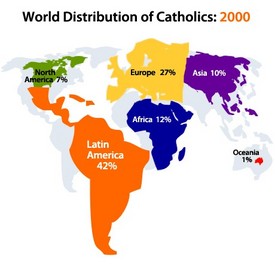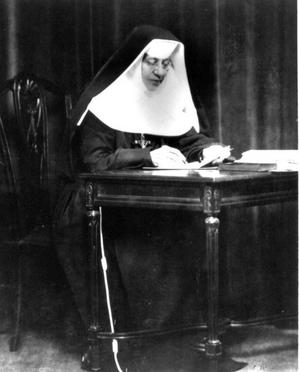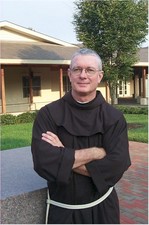Mike Aquilina’s
2007 “An Introduction to Lent” is a helpful reminder of what we ought to thoughtfully (and prayerfully) consider doing …. Here is part I:
It’s not so much by the ash mark on your forehead or fish marks on the calendar. Tradition tells us that Lent has three distinguishing marks: prayer, fasting and almsgiving.
This three-part series will examine those practices. Prayer is surely the best place to begin, because it’s the one that unites them all. Fasting and almsgiving are themselves just forms of prayer.
There are two classic definitions of prayer. The one in most catechisms comes from St. John of Damascus (eighth century): “Prayer is the raising of the mind and heart to God.” The other comes from St. Clement of Alexandria (third century). He defined prayer as “conversation with God.”
In prayer we talk to God, and He talks to us. As in any relationship, this conversation takes many forms. Think of all the ways a husband and wife communicate: formal marriage vows, casual chat, winks across a crowded room, affectionate caresses, and phrases they never tire of repeating.
Our communication with God includes a similar range of expressions — set phrases, quiet conversation, gestures such as the Sign of the Cross, and the intimate embrace of the sacraments. Just as a man and woman grow in love by repeating “I love you,” so we Christians grow in love by repeating the Church’s prayers.
Prayer comes in many forms and styles. These are usually divided into “vocal” and “mental” prayer. The categories are helpful, but not watertight. All prayer, after all, should involve our mind; so, in a sense, all prayer is mental prayer. Modern writers sometimes speak of the two types as formal prayer and spontaneous prayer.
Again, such distinctions are useful; we should, however, step beyond them for a moment. When we look at all prayer as conversation, it can change the way we go about it. Thinking of prayer as conversation can help us also to overcome obstacles — such as distractions, dryness, inability to focus — because all these things also come up in human conversation.
Prayer is a conversation that never ends. In the Scriptures, St. Paul says: “Pray at all times” (Ephesians 6:18); “Pray without ceasing” (1 Thessalonians 5:1); and “be constant in prayer” (Romans 12:12). He saw prayer as endless conversation.
That seems to be asking a lot, but it’s really the best way to think about it. If we are to pray this way, we have to form the habit of prayer. And, like any good habit or skill, prayer requires a sustained effort, over time, with much repetition.
Many people bristle when they hear about discipline in prayer. They think prayer should always be spontaneous. And sometimes prayer does come spontaneously, as when we experience some great joy or great sorrow. But spontaneity is most often the fruit of discipline. It is usually the best-trained musicians who are able to improvise freely. To do anything well takes time, dedication and patient endurance through sometimes-tedious exercises.
The most effective way to discipline our prayer life is by following a program, a schedule of sorts — what the late Cardinal Joseph Bernardin called “a game plan for the Christian.” The best time to set up such a plan is during Lent.
A “plan of life” is a firm but flexible program that schedules our prayer amid the ordinary duties of work, family life and social activity. A daily plan should include some vocal prayers, such as the Rosary or other devotions; plus reading of the Bible and some spiritual book (the writings of the saints are best); attendance at Mass (at least on Sundays and holy days, but more often if possible); and quiet time for more focused conversation with God in mental prayer. The best place for this prayer is in church, before Jesus in the tabernacle.
“Prayer first means God is speaking to us and not the other way around,” says Father Kenneth Myers, a priest of the Diocese of Pittsburgh. “That requires silence — the art of listening carefully to the Lord. And the best place to do that is in the presence of the Blessed Sacrament. Prayer before the Blessed Sacrament requires real effort and commitment, but even when our hearts are dry and it seems fruitless to keep on praying, being before the Eucharistic Lord is like being in the sunlight — even by doing nothing we still absorb those powerful rays of light.”
Our plan should also include weekly or monthly practices, such as confession, fasting, almsgiving and so on.
It helps to set standard times, or to key each practice to other activities, so that we never forget. We can keep our spiritual book by the coffee pot and read while the java is brewing every morning. We can use the beginning of our lunch hour as a reminder to say the Angelus. We can pray the Rosary while waiting for the bus home in the evening. We can listen to ten minutes of the Bible on tape as we drive.
We should plant prayers throughout the day like vines. Put one here, one there — and pretty soon, like ivy on a wall, our prayer will cover our day.
This is how Jesus modeled prayer for us. His own prayer life was rich and varied. Sometimes He offered formal prayers (Mark 12:29, 15:34). He kept holy days, made pilgrimages and attended the rich liturgy of the Jews (John 7:10-14). He also prayed spontaneously (John 11:41-42). He made time to pray alone in silence (Luke 3:21-22). Yet He also prayed together with His friends (Luke 9:18). He fasted, and He studied the Scriptures.
The first Christians followed their Lord in all these practices, and so do we.
Not that it’s always easy to do. But the formal quality of prayer helps us know what to do when we meet with obstacles. “Never, Never, never, never give up!” says my friend Steve Galvanek. A systems analyst, husband and dad, Steve says his plan sustains him even when he’s tired and preoccupied. “If in my feeble attempts to say a Rosary, I manage just one or two heartfelt Hail Marys, that’s far better than if I hadn’t tried at all”
Even the more unpleasant and difficult things in life can become reminders to pray. The key is to think of them as opportunities rather than obstacles. Another friend of mine, Sarah Scott, admits that it’s hard to find time to pray. She’s a mother of five, owner of a home-based business and volunteer at her children’s Catholic school. “It helps to offer everything up all the little things that you don’t like to do,” she says. “I hate folding laundry. But, instead of getting annoyed about it, I try to offer it up and think about what other people have to deal with. Efforts like this keep me talking with God throughout the day.”
Sounds like a plan.
 According to the recently published Annuario Pontificio, the papal yearbook we see the number of Catholics in the world has increased by 1.4%, with particularly in
According to the recently published Annuario Pontificio, the papal yearbook we see the number of Catholics in the world has increased by 1.4%, with particularly in 






 The outline of Katharine Drexel’s life is:
The outline of Katharine Drexel’s life is:

